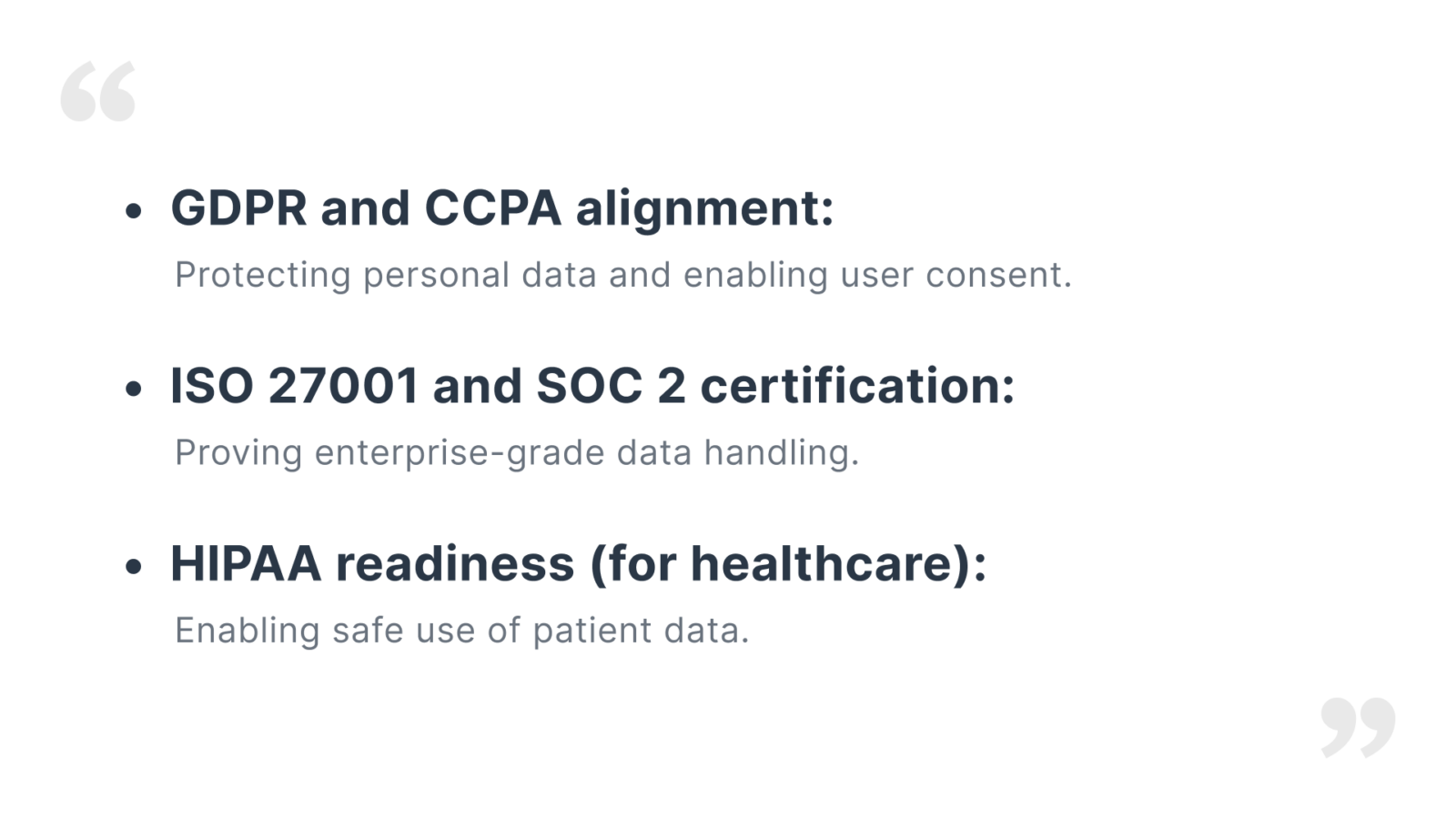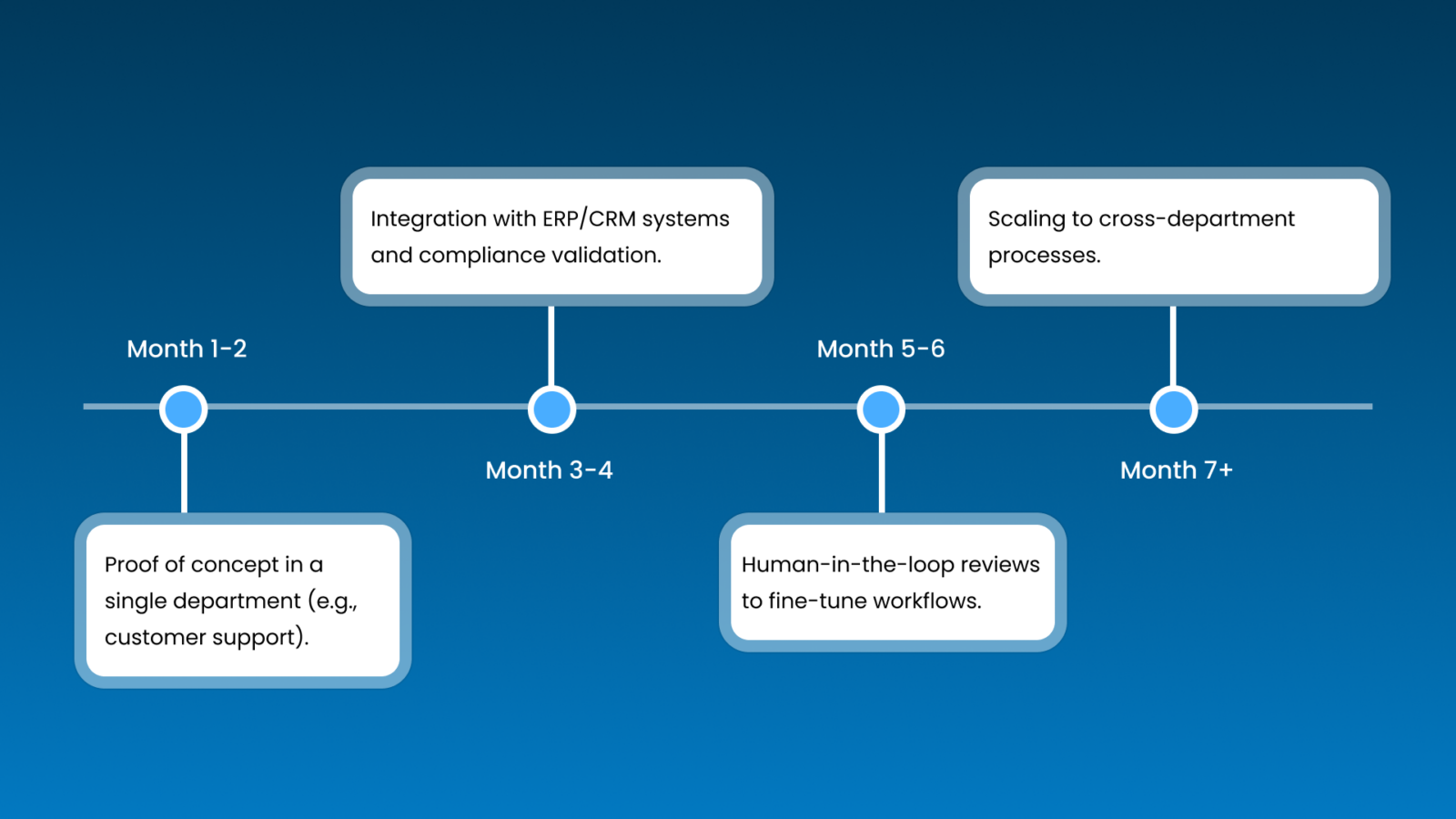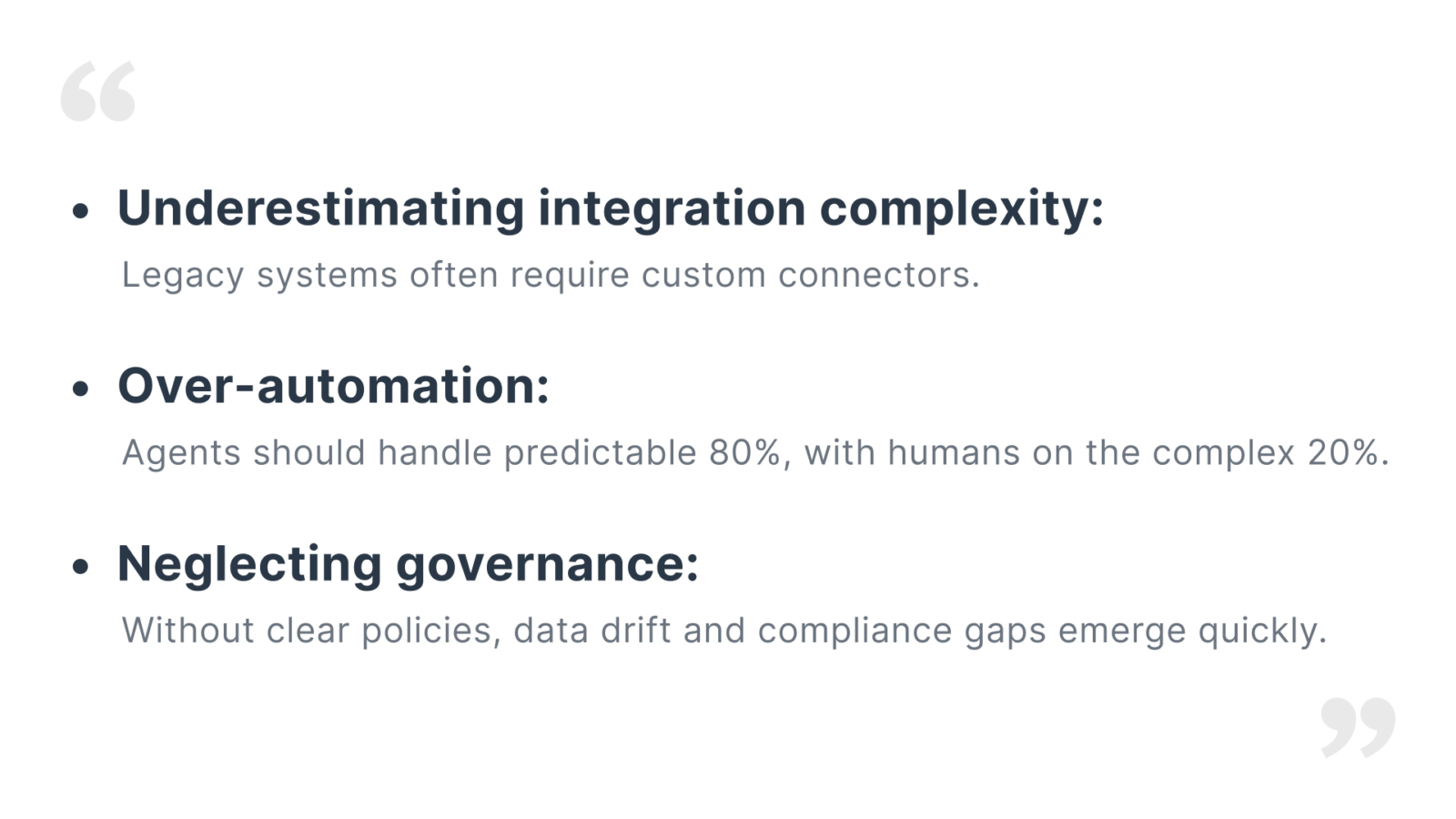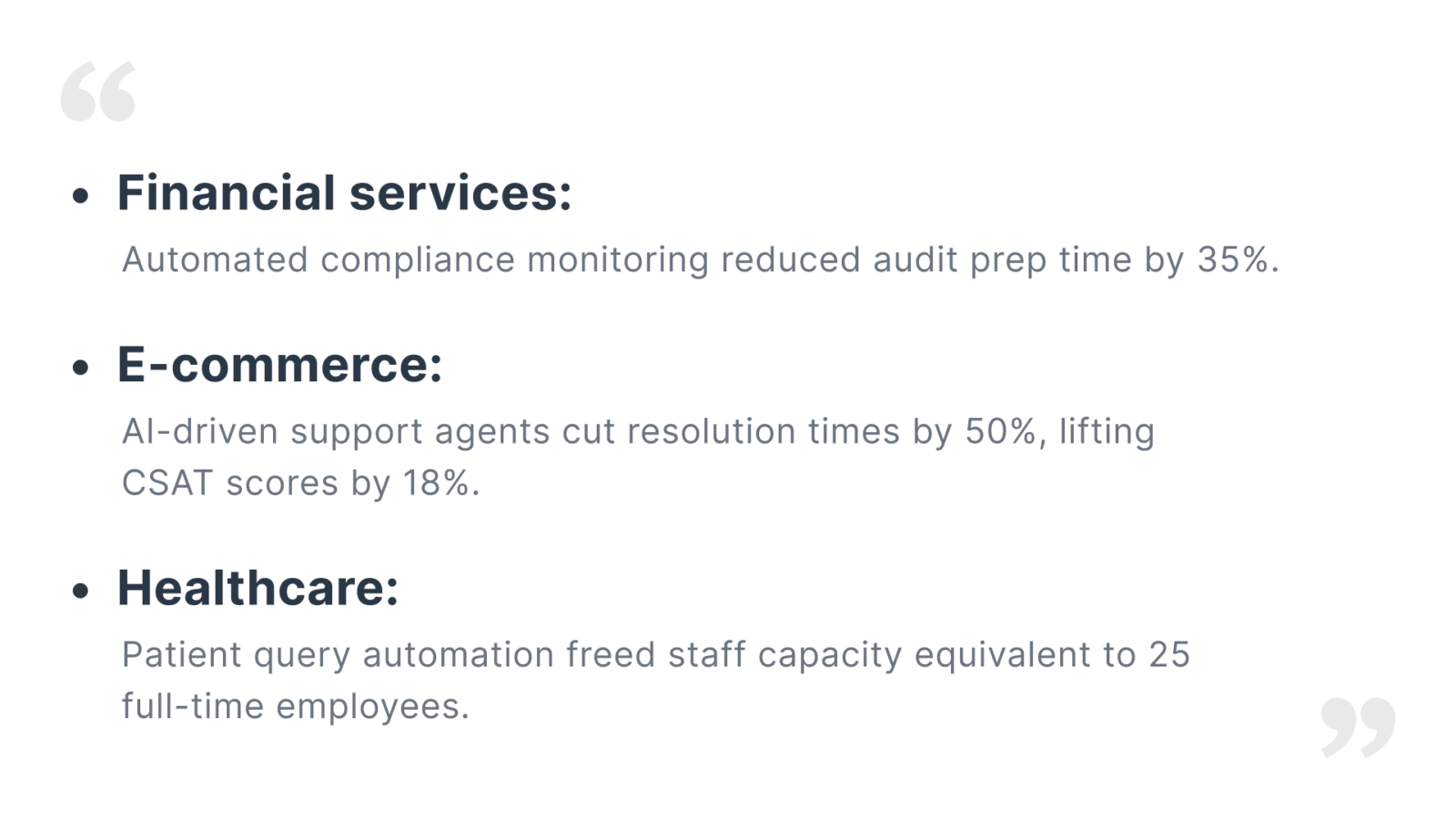AI Agents Platform: How Valletta Software Improves Business Efficiency by 40% in 2025

What are AI agents and why do enterprises need them?
An AI agent is more than just another piece of software. It’s an autonomous system that can sense its environment, make decisions, and act to achieve a goal. Four traits set agents apart in enterprise use: autonomy (they act without constant input), reactivity (they respond to events as they happen), proactivity (they anticipate needs), and social ability (they interact with humans and other systems).
This makes them very different from traditional chatbots or RPA scripts. A chatbot waits for a prompt; an RPA bot executes a predefined workflow. An AI agent, by contrast, can decide what needs to be done and how to do it, even if conditions change mid-task. That flexibility is why enterprises are now looking at agents as “digital colleagues” rather than just automation tools.
Remember, the more autonomy you give an agent, the more you need strong oversight. Without clear governance, an autonomous agent can make mistakes at scale just as easily as it can deliver efficiencies at scale.
Core characteristics of enterprise AI agents
Enterprise-ready agents share a set of non-negotiable capabilities:
- Autonomy: They can initiate actions, not just respond.
- Reactivity: They adapt to real-time data and events.
- Proactivity: They predict issues or opportunities before they surface.
- Social ability: They can work with humans and integrate across software ecosystems.
In practice, this means an agent might detect a customer service backlog, propose a plan to address it, and trigger actions in CRM and ticketing systems without waiting for a manager’s command.
Types of agents: conversational, automation, decision-support, monitoring
Most enterprise deployments group agents into four categories:
- Conversational agents handle customer or employee interactions, providing natural, human-like dialogue.
- Automation agents execute tasks across systems (resetting passwords, generating invoices, or managing approvals).
- Decision-support agents analyze large datasets, surface insights, and recommend actions, like identifying which sales leads are worth pursuing.
- Monitoring agents keep an eye on logs, compliance rules, or system health, triggering alerts or remediation steps when thresholds are breached.
Each type can exist alone, but in practice they often work together. For example, a monitoring agent might detect a compliance risk, then a decision-support agent evaluates it, and an automation agent takes corrective action.
Trade-offs between classic automation and agent-based systems
Classic automation (RPA, scripts, macros) is predictable and stable, but rigid. It works best in environments where nothing changes. AI agents, on the other hand, thrive in dynamic contexts: they can adjust paths and handle exceptions.
With classic automation, you gain reliability but lose flexibility. With AI agents, you gain adaptability and scale, but you must invest in oversight, explainability, and risk management.
For most enterprises, the sweet spot is a hybrid model: use RPA for highly repetitive, zero-variance tasks, and layer agents on top for areas where context and judgment matter.
How does Valletta’s AI Agent Platform work?
Valletta’s platform is built on a three-layer architecture designed to balance flexibility, scalability, and enterprise-grade reliability. At the top are business assistants that directly address use cases like customer service or finance. Beneath them sit functional agents – the cognitive engines that handle natural language, decision-making, and workflows. At the foundation is the tools layer, which connects agents to the enterprise ecosystem via APIs, databases, and ERP/CRM systems.
LangChain serves as the backbone of this architecture. It gives the platform modularity: each agent can call on external tools, query knowledge bases, or orchestrate multi-step actions without being hardcoded. This means enterprises can scale quickly, customizing agents for specific industries without rebuilding from scratch.
Modularity accelerates innovation, but it also increases integration complexity. Every new connector or workflow adds points of failure, so governance and monitoring become just as important as the agents themselves.
Business assistants: service, marketing, sales, finance, logistics, analytics
These are the visible “faces” of the platform – preconfigured assistants for core business domains.
- Service assistants manage customer tickets, escalations, and FAQs.
- Marketing assistants monitor competitors, personalize campaigns, and optimize spend.
- Sales assistants qualify leads, schedule follow-ups, and auto-generate proposals.
- Finance assistants reconcile invoices, track compliance, and generate reports.
- Logistics assistants forecast demand, optimize routes, and monitor supply chains.
- Analytics assistants detect anomalies, produce dashboards, and generate predictive insights.
For enterprises, these assistants translate complex AI capabilities into immediate business value.
Functional agents: NLP, decision engine, workflow, memory
Under the hood, functional agents handle the heavy lifting:
- NLP agents parse human language, extract intent, and manage context.
- Decision engines evaluate rules, weigh trade-offs, and choose actions.
- Workflow agents orchestrate multi-step processes across multiple systems.
- Memory agents store past interactions and outcomes, enabling long-term learning and personalization.
Together, they form a flexible cognitive layer that can adapt to industry-specific requirements.
Integration layer: APIs, databases, ERP/CRM connectivity
At the foundation lies the integration layer. This is where the platform connects to the real world:
- APIs link agents to CRMs (Salesforce, HubSpot), ERPs (SAP, Oracle), or ticketing systems.
- Databases provide structured and unstructured data access.
- Streaming connectors (Kafka, event buses) enable real-time responsiveness.
This layer is critical: without it, agents remain “smart” but disconnected. With it, they can drive real change by acting directly inside enterprise workflows.
Where do AI agents deliver measurable results?
AI agents shine where processes are repetitive, data-heavy, and time-sensitive. In these environments, they cut costs, accelerate throughput, and free people from low-value work. Our experience shows the biggest gains in customer service, marketing, sales, finance, logistics, and analytics.
Automation handles 70–80% of routine tasks with precision, but unique or edge cases still need human oversight. Relying too heavily on agents without escalation paths risks frustrating customers or introducing silent errors into critical processes.
Customer service: 24/7 support and workload reduction
Agents provide always-on support, answering common questions, resolving routine issues, and escalating only when necessary. For example, ticket triage and refund handling can be fully automated, cutting resolution times from hours to minutes.
One agent can process thousands of requests in parallel, reducing backlog and response times. Human agents are then free to focus on complex, high-empathy interactions.
Marketing & sales: lead scoring, personalization, revenue growth
Marketing and sales teams benefit from agents that scan leads, qualify prospects, and personalize campaigns. Agents can track competitor activity, adjust bids in real time, and trigger follow-ups automatically.
The result is higher conversion rates and faster pipeline movement. Companies often see double-digit improvements in lead-to-deal conversion within the first quarter of deployment.
Finance & logistics: compliance, forecasting, supply chain optimization
In finance, agents reconcile transactions, monitor compliance rules, and generate audit-ready reports. In logistics, they forecast demand, optimize routes, and flag disruptions before they cascade.
The measurable gain – lower operational costs and fewer compliance penalties. For supply chains, it means fewer stockouts and better utilization of assets.
Analytics: anomaly detection and predictive insights
Analytics agents sift through logs, sales records, or sensor data to detect anomalies that humans would miss. They also run predictive models, helping managers act before problems occur whether that’s a system failure, churn risk, or a sudden market shift.
This turns raw data into actionable intelligence, with insights delivered in real time rather than days or weeks later.
How does Valletta ensure security, privacy, and quality?
Enterprises won’t adopt AI agents if they can’t trust them. Our platform is designed with zero-trust principles and compliance baked in from the start, covering frameworks like GDPR, ISO 27001, and SOC 2. Security is reinforced by encryption, role-based access control, and audit logging.
Equally important, we embed human-in-the-loop validation and explainable AI features, ensuring agents’ decisions can be inspected, challenged, and improved. This balance of automation with oversight builds confidence that agents add value without compromising safety.
Strict quality and compliance controls slow down deployment and require more resources. But in regulated industries, the cost of going fast without safeguards is far higher than the cost of doing it right.
Privacy and compliance framework
Our compliance framework ensures agents operate within global and industry-specific regulations.

This framework isn’t just paperwork; it’s implemented through real safeguards like automated data redaction, access control, and regular compliance audits.
Security and confidentiality model
Security is based on zero-trust architecture: every request is verified, every agent action is logged, and no component is trusted by default. Key measures include:
- End-to-end encryption for data in motion and at rest.
- Fine-grained RBAC (role-based access control) for users and agents.
- Multi-tenant isolation to ensure one client’s data never touches another’s.
These layers reduce the attack surface and protect against both internal misuse and external threats.
Quality control: validation, monitoring, continuous improvement
We combine automation with human validation to maintain reliability:
- Human-in-the-loop reviews catch errors before they scale.
- Explainable AI tools show how decisions were made.
- Monitoring and feedback loops allow continuous retraining and improvement.
This creates a living system where agents get smarter over time, while enterprises retain ultimate control over accuracy and accountability.
Step-by-step implementation guide
Deploying AI agents is not a plug-and-play exercise. Success comes from treating it as a staged program: starting small, proving value, and then scaling carefully. We typically recommend a lean team of 8-12 specialists (engineers, data scientists, product owners, and compliance leads) to manage the rollout.
A well-run implementation delivers fast ROI (sometimes within months) but it requires upfront investment in infrastructure, integration, and governance to make sure the gains are sustainable.
Step 1. Proof of concept and pilot
Start with a narrowly scoped use case: one process, one department, one agent. The goal is not to automate everything at once, but to validate the technology and measure ROI quickly. Success criteria should be explicit (e.g., reduce average ticket handling time by 30% within 90 days).
Step 2. Integration and monitoring setup
Once the pilot works, connect the agent to enterprise systems through APIs, databases, and event streams. Monitoring and logging should be enabled from day one so that every action can be audited. This step ensures the agent is not just “smart,” but also accountable and traceable.
Step 3. Human-in-the-loop validation
Before agents are fully trusted, keep humans in the review loop. Let the agent handle tasks, but require human approval for critical decisions. This phase builds confidence, exposes edge cases, and allows the organization to fine-tune workflows without risking service quality.
Step 4. Scaling and cross-department workflows
With pilots validated, expand into more complex, cross-department processes, such as a workflow that spans customer service, finance, and logistics. At this stage, agents can pass tasks to one another, enabling end-to-end automation.
📌 Example: A mid-sized SaaS company cut its support ticket backlog by 55% in three months with a single agent. After proving the value, they extended agents into finance reporting and developer operations.
Case Study: How Valletta Software built an AI agent platform
We didn’t just design an AI agent platform in theory, we put it into practice across multiple industries. In finance, e-commerce, and healthcare, our deployments delivered up to 40% efficiency gains and measurable cost reductions. By freeing employees from repetitive tasks, companies were able to reinvest time into strategy, compliance, and customer care.
The flexibility of an agent-based system comes with higher demands on data governance. The more adaptive and proactive agents become, the more important it is to enforce strict policies on data quality, lineage, and compliance.
Real implementation timeline: from setup to results
Most enterprises see results within months, not years. A typical path looks like this:

In one healthcare deployment, the platform went from pilot to full-scale patient support automation in just under six months.
Lessons learned: pitfalls and how to avoid them
Through real-world projects, we identified recurring pitfalls:

Avoiding these issues requires upfront investment in integration planning, balanced automation strategy, and robust data governance.
ROI demonstration: cost savings and customer satisfaction metrics
Across pilots and scaled rollouts, the ROI has been telling:

In most cases, the platform paid for itself within the first year through cost savings and measurable improvements in customer experience.
Frequently Asked Questions (FAQ)
Agents can pass tasks between one another like an assembly line. A monitoring agent flags an anomaly, a decision-support agent evaluates its severity, and an automation agent triggers remediation. This orchestration allows end-to-end workflows without constant human intervention, improving speed and reducing operational bottlenecks.
Yes. While cloud-native APIs are faster to connect, we also provide connectors and middleware for legacy ERPs, CRMs, and even on-premise databases. This ensures enterprises don’t need a full system overhaul to adopt AI agents. Integration may take longer, but it’s fully achievable.
A single-agent system handles one scope of work like customer support triage. Multi-agent systems involve several agents with different roles working together. The benefit is flexibility and scalability: multi-agent setups can solve more complex, cross-department problems, though they also require stronger monitoring and governance.
The platform includes explainable AI (XAI) features: decision logs, reasoning traces, and model outputs that can be reviewed by humans. This transparency allows compliance teams and managers to understand why an agent made a specific choice, building trust and accountability in regulated environments.
Yes. Our agents use advanced NLP models with multilingual support, covering major global languages. This means an agent can seamlessly switch between English, Spanish, German, or Mandarin in real time. For enterprises, this unlocks global 24/7 customer support without scaling human teams in every market.
Enterprises need a mix of technical and operational expertise: engineers for integration, data specialists for governance, and product or operations managers to align use cases with business goals. Teams don’t need deep AI research knowledge as our low-code/no-code tools reduce technical barriers significantly.
Most companies start with a single-agent pilot and scale to multiple agents within 6-12 months. The speed depends on system readiness, governance frameworks, and internal adoption. With proper infrastructure in place, adding new agents becomes incremental rather than a full reinvention.
Memory allows agents to retain context across sessions. For example, a customer service agent remembers previous tickets, or a finance agent keeps track of recurring compliance patterns. This persistence makes agents more personalized, accurate, and efficient, moving them closer to human-like collaboration.
Our platform includes dashboards, activity logs, and alerting systems. Every agent action is logged for auditing, and anomalies trigger notifications to human supervisors. Real-time monitoring ensures agents remain aligned with business policies and that errors can be caught before they escalate.
Early adopters benefit from cost savings, faster decision-making, and customer loyalty before their competitors catch up. More importantly, they build institutional knowledge on how to govern, scale, and integrate agents effectively: experience that becomes a lasting competitive moat as adoption spreads across industries.